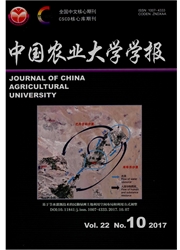

 中文摘要:
中文摘要:
以富营养化官厅水库(北京)和天然Rupa湖(尼泊尔)沉积物为对象,使用16Sr DNA克隆文库的分子生态学方法,鉴定并比较了其中的细菌群落结构。分析表明:二者pH及各形态磷含量参数差异显著。在细菌组成上,二者的主要种群均为变形杆菌门,且均以β-变形杆菌纲为主(比例高于50%),但Rupa湖沉积物中以α-变形杆菌次多,而官厅水库沉积物以γ-变形杆菌次多,2个样品中δ-变形杆菌的含量均相对较少。其他种群组成上,官厅水库沉积物中绿弯菌纲(9.21%)含量高于Rupa湖(1%),并特有芽单胞菌纲(12.2%)、放线菌纲(1.3%)和芽孢杆菌纲(0.8%)。而Rupa湖沉积物中特有的种群为螺旋菌纲(2%)、绿菌纲(1%)、梭菌纲(1%)和疣微菌纲(0.3%)。官厅水库和Rupa湖沉积物均含有少量的酸杆菌纲细菌。
 英文摘要:
英文摘要:
Bacterial communities of sediments from Guanting Reservoir(Beijing) and Rupa Lake(Nepal) were studied using method of 16S rDNA clone library.In the sediments,pH and concentration of total phosphorus and phosphorus fractions were obviously different.Bacterial communities of the two samples were both dominant by phylum of Proteobacterium,in which the percentage of β-proteobacterium was highest(50%).The second dominant bacteria cluster of sediment from Rupa Lake is α-Proteobacterium,other than γ-Proteobacterium in that from Guanting Reservoir.δ-Proteobacterium in both samples was much less.In sediment from Guanting Reservoir,percentage of Chloroflexi(9.21%) was much higher than that of Rupa Lake(1%),and Gemmatimonadetes(12.2%),Acidobacteria(1.3%) and Bacilli(0.8%) were peculiar.Sediment of Rupa Lake is peculiar of Spirochaetes(2%),Chlorobi(1%),Clostridia(1%) and Verrucomicrobiae(0.3%).There were less Actinobacteridae in sediment of Guanting Reservoir and Rupa Lake.
 同期刊论文项目
同期刊论文项目
 同项目期刊论文
同项目期刊论文
 Genome Sequence of the Polyphosphate-Accumulating Organism Arthrobacter sp. Strain PAO19 Isolated fr
Genome Sequence of the Polyphosphate-Accumulating Organism Arthrobacter sp. Strain PAO19 Isolated fr Removal of low concentration of phosphorus from solution by free and immobilized cells of Pseudomona
Removal of low concentration of phosphorus from solution by free and immobilized cells of Pseudomona Biogeochemical function of phosphorus-solubilising bacteria on cycling of phosphorus at the water-se
Biogeochemical function of phosphorus-solubilising bacteria on cycling of phosphorus at the water-se Salisediminibacterium halotolerans gen. nov., sp. nov., a halophilic bacterium from soda lake sedime
Salisediminibacterium halotolerans gen. nov., sp. nov., a halophilic bacterium from soda lake sedime Preparation of ZnS:Ni/ZnS quantum dots with core/shell structure and application for detecting cefop
Preparation of ZnS:Ni/ZnS quantum dots with core/shell structure and application for detecting cefop Study on Phosphorus Distribution from Sediment of Different Trophic Area of Taihu Lake and Its Tempo
Study on Phosphorus Distribution from Sediment of Different Trophic Area of Taihu Lake and Its Tempo Biogeochemical function of phosphorus-solubilising bacteria on cycling of phosphorus at the water&nd
Biogeochemical function of phosphorus-solubilising bacteria on cycling of phosphorus at the water&nd 期刊信息
期刊信息
